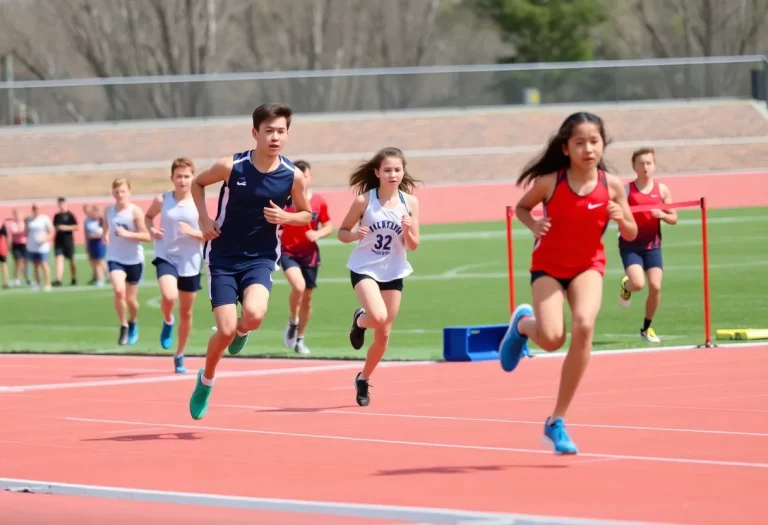News Summary
The N.F.H.S. Track and Field Rules Committee has approved new rules for the upcoming 2026 season aimed at enhancing athlete safety and competition consistency. Key updates include new javelin specifications, updated warm-up guidelines for jumpers, padding requirements for elevated surfaces, and adjustments for indoor track events. These changes reflect a commitment to standardizing practices and improving the experience for athletes, coaches, and officials. As the new season approaches, participants are encouraged to familiarize themselves with these important updates.
Exciting Changes Coming to High School Track and Field Rules for 2026 Season in Indianapolis!
Here’s some thrilling news for athletes, coaches, and track and field enthusiasts! The N.F.H.S. Track and Field Rules Committee has officially given the green light for several important changes, including brand new specifications for the javelin. These updates are effective for the upcoming 2026 season and aim to enhance the overall experience for everyone involved in high school track and field.
Why the Changes Matter
The need for clarity and safety in competitions has never been more apparent, and that’s where these new rules come into play. By adding specific javelin specifications to the N.F.H.S. Track and Field Rules Book, the committee is working to provide a much-needed framework. This move will ensure that athletes have access to uniform equipment standards, making it easier for coaches and meet officials to navigate the complexities of the sport. After all, understanding what’s required can make a big difference in a student-athlete’s performance and safety!
What’s New in the Rule Book?
Among the 11 approved changes, there are several that focus on athlete safety, especially concerning warm-up periods. Under New Rule 6-8-6, high jumpers and pole vaulters who haven’t had a chance to compete for over 60 minutes will now be allowed to warm up. This warm-up must occur under official supervision and will not involve a crossbar or bungee cord, helping to minimize any risks that can come with periods of inactivity. It’s a proactive approach to ensuring that athletes are prepared when it’s their turn to shine on the field.
Another crucial update is found in Rules 6-9-21 and 6-9-28, which clarify padding requirements for elevated surfaces. This addition underscores the commitment to reduce fall-related injuries, which have remained a concern. By requiring padding on “items above ground level,” high school track and field events strive to uphold a higher safety standard for all participants.
Changes for Long Jump, Triple Jump, and Indoor Events
In the world of jumping events, Rule 3-2-3 gives the games committee the authority to determine takeoff board distances in long jump and triple jump. This alignment with existing practices enhances the consistency of meet management. Additionally, athletes and coaches can expect some flexibility in indoor track events. The introduction of Rule 9-1-1 allows states to opt for a 200-meter dash in place of the typical 300-meter dash, adapting to facility sizes and needs.
Indoor relay teams will benefit from a more standardized process as Rule 9-6-1 establishes a uniform 20-meter exchange zone. This change aims to improve the flow of indoor events, making interventions smoother and communication clearer for those overseeing the races.
Final Touches on Rules and Regulations
There’s even more to get excited about! Rule 4-6-6c prohibits athletes from using audio or video recording devices during events, ensuring that focus remains on performance. The introduction of Rule 6-2-2 NOTES ensures that time limits for consecutive attempts during height changes are clearly outlined. In addition, Rule 6-3-2b4(a) simplifies the method for metric measurements used in tie-breaking, aligning with existing competition practices.
All these changes reflect the N.F.H.S.’s commitment to standardizing competition and enhancing athlete safety, particularly as participation in javelin and other events continues to grow. For the complete list of rule changes, participants can visit the N.F.H.S. website.
As we gear up for the 2026 season, it’s clear that these updates are all about ensuring a safer, more enjoyable experience for everyone on the track and field. So, athletes, coaches, and fans—get ready for a fantastic season ahead!
Deeper Dive: News & Info About This Topic
LIVE BALL Resources
Kokomo Welcomes New Boys Basketball Coach Drew Schauss
Tennessee High School Football Season Anticipation Builds for 2025
New High School Baseball Rules Set for 2027
Major Changes in High School Football for 2025 Season
New Rules Transform High School Baseball Starting in 2027
Brody Baker Transfers to Harrison High School Basketball Team
Controversy and Triumph at Minnesota High School Track Meet
California’s AB Hernandez Sparks Debate in Sports Community
Vermont High School Spring Playoffs Kick Off
Keller’s Swim Team Exits Investigation Unscathed
Additional Resources
- KX News: NFHS Track and Field Rules Committee Approves Javelin Specifications for ND
- Wikipedia: Javelin Throw
- AZPreps365: Addition of Javelin Specifications Highlight Track and Field Rules Revisions
- Google Search: 2026 Track and Field Rule Changes
- Sports Illustrated: NFHS Approves Major High School Track and Field Rule Changes for 2026, Adds Javelin Specs
- Google Scholar: NFHS Track and Field Rules 2026
- Northwest MO Info: False Start Clarification Made by NFHS in New Track and Field Rules
- Encyclopedia Britannica: NFHS Track and Field Rules
- MileSplit: NFHS No More Jewelry Rule for High School Track & Field
- Google News: NFHS Track and Field


